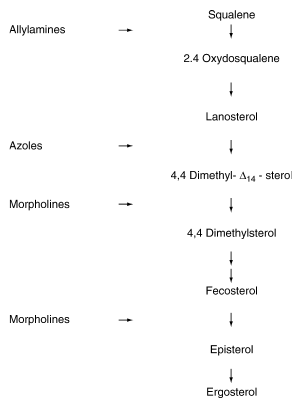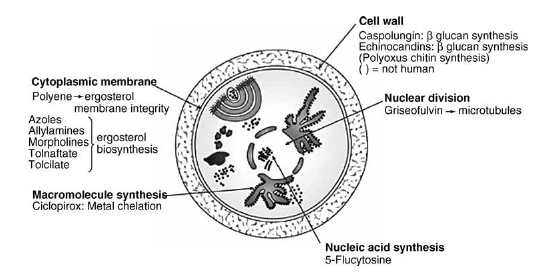Antifungal agents are a group of drugs used to treat infections caused by fungi.
Diseases caused by fungal infection may affect different parts of the body, so for different cases the patient should use different antifungal drugs. For example, treatment can be performed both on surface area (skin, nails, genitals), and internal organs (heart, lungs). Antifungal drugs affect the fungal cell wall, causing the cells to derive from the vital substance.
Antifungals are used to treat pulmonary fungal infections (athlete’s foot), as well as potentially dangerous fungal infection (aspergillosis).
For the treatment of infections of the skin patient should use smooth and scalp cream or a shampoo containing, for example, miconazole. After about a week symptoms begin to disappear, but the treatment must continue for at least another two weeks. Terbinafine is used orally for several months to effectively treat nail infections. Clotrimazole (cream or vaginal suppository) is used for thrush. If thrush occurs, fluconazole is administered orally.
In case of severe infections of internal organs patients are prescribed injections, such as amphotericin B, and then a course of antifungal oral medication.
Mycosis (fungal infections of the skin) forms a significant part of the infectious diseases, that represent not only medical, but often a social problem, and has a negative effect on the patient’s life quality. Fungal infections are characterized by the prevalence of emergency; they have a tendency to chronic course, and resistance to even the most modern methods of treatment. At least 20% of the world’s population suffers from mycosis, and in some regions increased incidence of foot mycosis is noticed, (such as microsporia, candidiasis, etc.) Persistent and generalized forms of fungal infections are often a sort of “marker” of HIV infection, and therefore the increases their diagnostic role.
All treatments for fungal infections directly or indirectly aim at removing the causes of the pathogenic fungus. Causal therapy is an effective approach to the treatment of fungal infections. Treatments can be local (external), when the drug is applied to the affected area. An important criterion to determine the choice of a drug is the spectrum of its actions.
Now dermatologists systemically offer active antifungal modern facilities. With the introduction of the practice of systemic antimycotics, patients have real opportunity to get relieved from onychomycosis. Today there is a wide selection of these drugs. Physicians determine the need for taking medicines, set the shcedule and duration of the treatment.
Currently there are five antifungal agents for oral use. They are griseofulvin, ketoconazole, terbinafine, itraconazole, and fluconazole.
In our time, more and more fungi affects not only the skin and mucous membranes in contact with the external environment, but also the internal organs. Secondary infections caused by opportunistic fungi (candidiasis and aspergillosis) have great social importance. They contribute to the emergence of low immunity, the use of antibiotics, antineoplastic agents, cytotoxic agents, corticosteroids, and others to treat them, as well as for the treatment of severe fungal infections of the skin and mucous membrane antifungals are used as drugs for systemic use.
Antifungal drugs
The most commonly used drugs are azoles. They are well absorbed from the gastrointestinal tract. Their relative bioavailability can be arranged in series: Itraconazole (40-60%)

Antifungal drugs – targets of antifungal activity



 (9 votes, average: 4.44 out of 5)
(9 votes, average: 4.44 out of 5)















